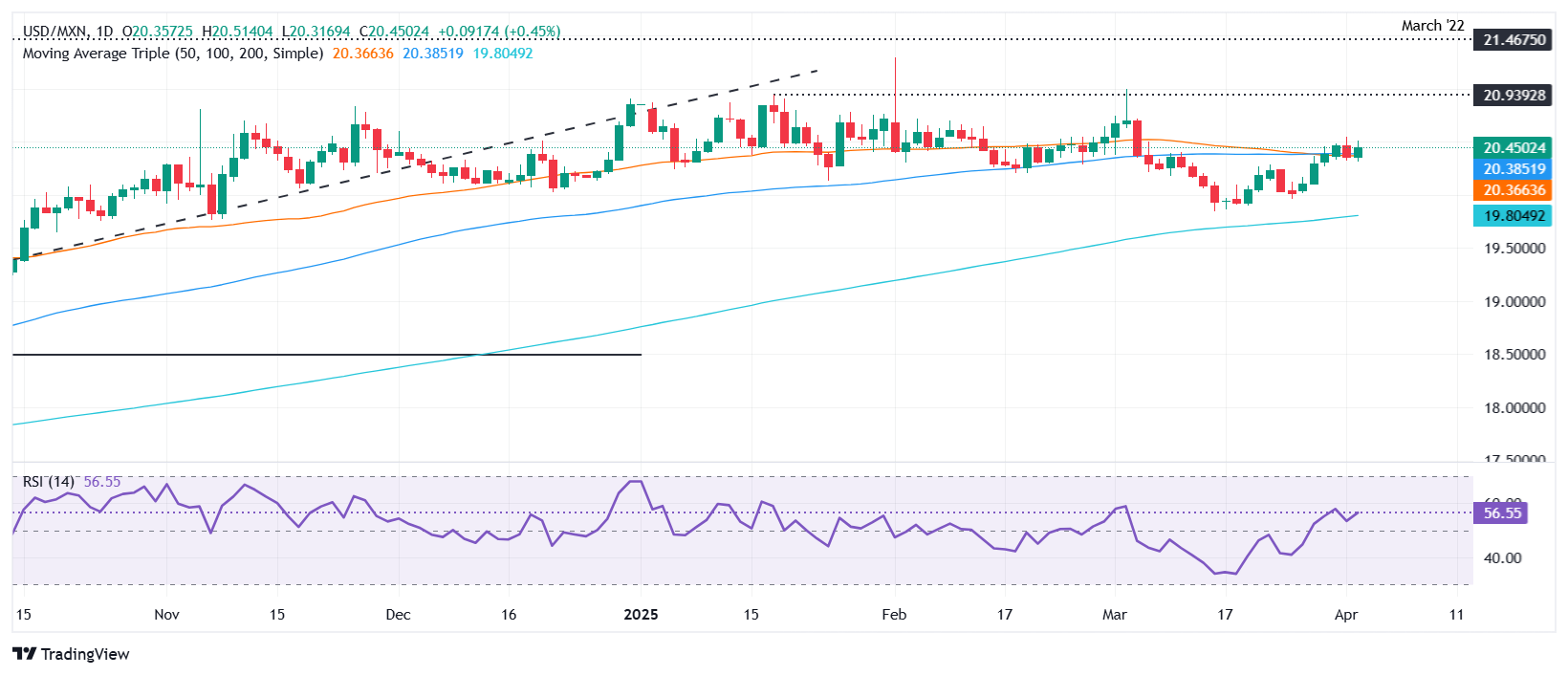- USD/MXN rises to 20.47 as risk lingers over auto tariffs hitting Mexico; Sheinbaum vows no retaliation, dampening Peso support.
- Emerging market currencies are under pressure as markets brace for possible 25% tariffs on USMCA car exports.
- Mexico’s Finance Ministry cuts 2025 growth forecast; OECD sees potential 1.3% GDP contraction.
The Mexican Peso (MXN) remains on the defensive against the US Dollar (USD), trading with losses of more than 0.50% as traders await US President Donald Trump’s Liberation Day announcement later today. At the time of writing, USD/MXN is exchanging hands at 20.47.
The market mood improved, yet the emerging market currency remains stagnant as market participants await Trump’s tariff announcement. Although there is a chance that the fentanyl-related tariffs on Canada and Mexico may be lifted, there is a risk that the 25% tariffs on cars could be extended to United States-Mexico-Canada Agreement (USMCA) countries.
In the meantime, Mexico’s President Claudia Sheinbaum said she would not impose tit-for-tat tariffs, sparking a dip in the USD/MXN pair, which buyers bought, keeping the exotic pair within familiar levels.
Mexico’s Finance Ministry announced that it would narrow the fiscal deficit in 2026. According to Bloomberg, “Sheinbaum’s administration said it will target a budget gap of 3.2% to 3.5% of gross domestic product next year, smaller than this year’s ambitious estimate of 3.9% to 4%.”
The ministry revised its 2025 growth forecast downward to around 1.5%-2.3%, a very optimistic scenario compared to Banco de Mexico’s (Banxico) 0.6% estimate. The Organization for Economic Co-operation and Development (OECD) predicts Mexico’s GDP will contract by 1.3%.
Data in the US revealed a strong labor market, with companies hiring more people than expected by economists, surpassing the February reading. At the same time, Factory Orders expanded above forecasts but dipped compared to January’s figures.
Ahead this week, Mexico’s economic agenda will feature Gross Fixed Investment figures and Consumer Confidence data. In the US, traders are focusing on the Trump tariff announcement, the ISM Services PMI for March, Nonfarm Payroll figures, and Fed Chair Jerome Powell’s speech.
Daily digest market movers: Mexican Peso falls on uncertainty about tariffs
- Mexico’s Business Confidence deteriorated sharply in February, according to INEGI. Meanwhile, S&P Global reported that manufacturing activity contracted for the fifth consecutive month.
- Banxico’s Governor, Victoria Rodríguez Ceja, stated that the central bank will remain attentive to US trade policies and their impact on the country, with a primary focus on inflation, as she noted in an interview with El Financiero.
- In March, the ADP National Employment Report revealed that businesses added 155,000 people to the workforce, exceeding the forecast of more than 105,000 jobs and up from the 84,000 jobs created in February.
- Other data showed that Factory Orders in February exceeded estimates of 0.5% and expanded 0.6% MoM, down from 1.8% in January.
- At 20:00 GMT, Donald Trump is expected to announce the imposition of reciprocal tariffs on trading partners in the White House Rose Garden.
- JP Morgan supports an additional 50 bps cut in Mexico due to the risks of an imminent recession, according to analyst Steven Palacio. Palacio added that Mexico would be tapped into a recession spread by tariffs and “uncertainty surrounding their implementation.”
USD/MXN technical outlook: Mexican Peso treads water as USD/MXN climbs above 20.40
USD/MXN remains upwardly biased, trading near its weekly high of 20.54, yet is contained due to uncertainty about the outcome of the tariff. If duties are applied with no exemptions, the Peso could depreciate sharply. In that outcome, the pair could challenge the March 4 high at 20.99, followed by the February 3 peak of 21.28.
On the other hand, if Mexico is exempt from tariffs due to the US adhering to the USMCA free trade rules, USD/MXN could dip below the first support level, seen at the confluence of the 50- and 100-day Simple Moving Averages (SMAs) around 20.35/36, followed by the 20.00 mark. A breach of the latter will expose the 200-day SMA at 19.76.

Mexican Peso FAQs
The Mexican Peso (MXN) is the most traded currency among its Latin American peers. Its value is broadly determined by the performance of the Mexican economy, the country’s central bank’s policy, the amount of foreign investment in the country and even the levels of remittances sent by Mexicans who live abroad, particularly in the United States. Geopolitical trends can also move MXN: for example, the process of nearshoring – or the decision by some firms to relocate manufacturing capacity and supply chains closer to their home countries – is also seen as a catalyst for the Mexican currency as the country is considered a key manufacturing hub in the American continent. Another catalyst for MXN is Oil prices as Mexico is a key exporter of the commodity.
The main objective of Mexico’s central bank, also known as Banxico, is to maintain inflation at low and stable levels (at or close to its target of 3%, the midpoint in a tolerance band of between 2% and 4%). To this end, the bank sets an appropriate level of interest rates. When inflation is too high, Banxico will attempt to tame it by raising interest rates, making it more expensive for households and businesses to borrow money, thus cooling demand and the overall economy. Higher interest rates are generally positive for the Mexican Peso (MXN) as they lead to higher yields, making the country a more attractive place for investors. On the contrary, lower interest rates tend to weaken MXN.
Macroeconomic data releases are key to assess the state of the economy and can have an impact on the Mexican Peso (MXN) valuation. A strong Mexican economy, based on high economic growth, low unemployment and high confidence is good for MXN. Not only does it attract more foreign investment but it may encourage the Bank of Mexico (Banxico) to increase interest rates, particularly if this strength comes together with elevated inflation. However, if economic data is weak, MXN is likely to depreciate.
As an emerging-market currency, the Mexican Peso (MXN) tends to strive during risk-on periods, or when investors perceive that broader market risks are low and thus are eager to engage with investments that carry a higher risk. Conversely, MXN tends to weaken at times of market turbulence or economic uncertainty as investors tend to sell higher-risk assets and flee to the more-stable safe havens.

